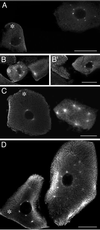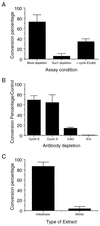Cyclin-dependent kinase control of centrosome duplication
- PMID: 10077594
- PMCID: PMC15852
- DOI: 10.1073/pnas.96.6.2817
Cyclin-dependent kinase control of centrosome duplication
Abstract
Centrosomes nucleate microtubules and duplicate once per cell cycle. This duplication and subsequent segregation in mitosis results in maintenance of the one centrosome/cell ratio. Centrosome duplication occurs during the G1/S transition in somatic cells and must be coupled to the events of the nuclear cell cycle; failure to coordinate duplication and mitosis results in abnormal numbers of centrosomes and aberrant mitoses. Using both in vivo and in vitro assays, we show that centrosome duplication in Xenopus laevis embryos requires cyclin/cdk2 kinase activity. Injection of the cdk (cyclin-dependent kinase) inhibitor p21 into one blastomere of a dividing embryo blocks centrosome duplication in that blastomere; the related cdk inhibitor p27 has a similar effect. An in vitro system using Xenopus extracts carries out separation of the paired centrioles within the centrosome. This centriole separation activity is dependent on cyclin/cdk2 activity; depletion of either cdk2 or of the two activating cyclins, cyclin A and cyclin E, eliminates centriole separation activity. In addition, centriole separation is inhibited by the mitotic state, suggesting a mechanism of linking the cell cycle to periodic duplication of the centrosome.
Figures



References
Publication types
MeSH terms
Substances
LinkOut - more resources
Full Text Sources

